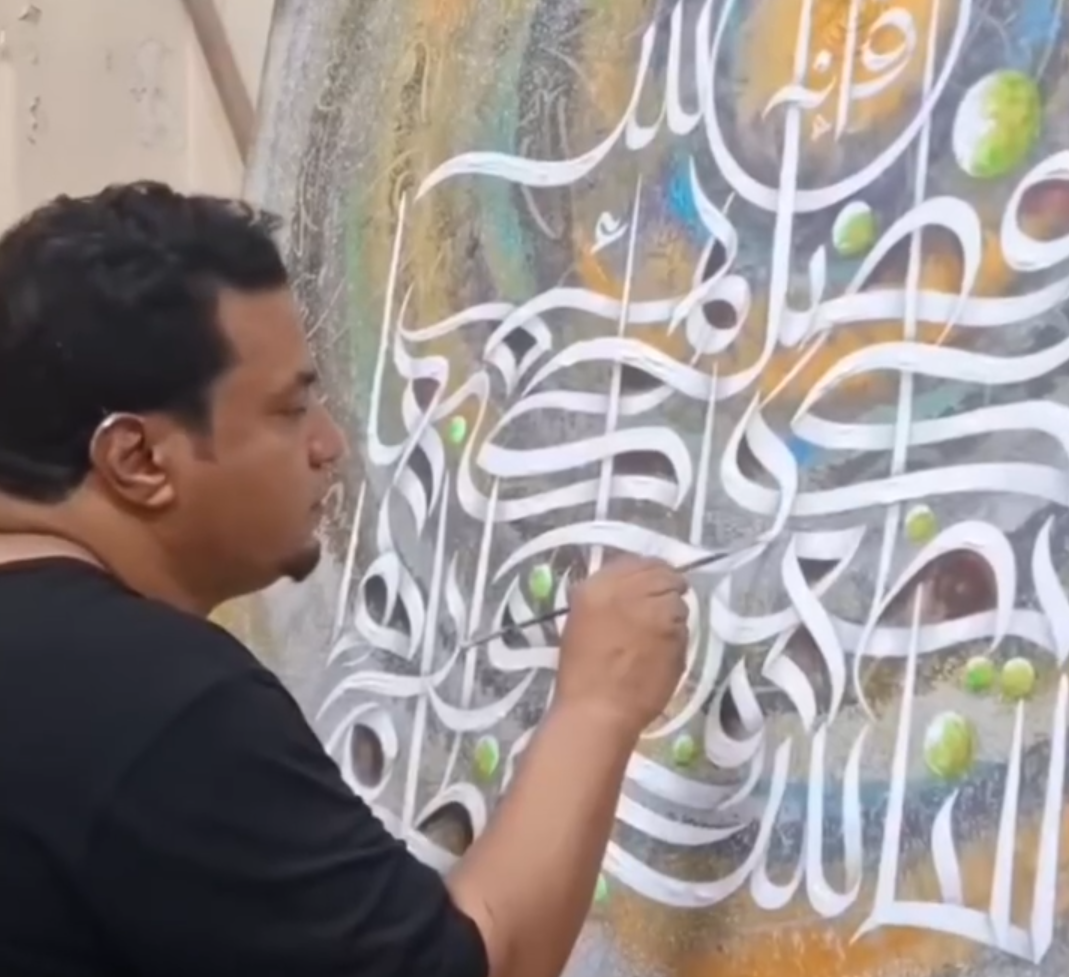
Foyez Ahmed
 Arabic Calligraphy, Islamic Art, Graphic Design, Art Market, Cultural Heritage, Contemporary Art, Typography, Branding, Calligraffiti
Arabic Calligraphy, Islamic Art, Graphic Design, Art Market, Cultural Heritage, Contemporary Art, Typography, Branding, Calligraffiti
 0 تعليق
0 تعليق
 25 Jun, 2025
25 Jun, 2025

Arabic calligraphy, an art form deeply rooted in spiritual devotion and cultural identity, is experiencing a vibrant resurgence in the 21st century. Far from being confined to ancient manuscripts and mosque walls, this fluid and intricate script is finding new life in diverse fields, from high-end graphic design to street art, proving its timeless appeal and adaptability.
For centuries, Arabic calligraphy has been revered as the pinnacle of Islamic art. Its evolution from a mere tool of communication to an elaborate visual language is intrinsically linked to the Holy Quran, where the act of writing became an act of worship. Masters meticulously honed various styles like the angular Kufic, the elegant Thuluth, the practical Naskh, and the ornate Diwani, each with its unique aesthetic and purpose. This rich history has imbued Arabic script with profound meaning and a unique artistic vocabulary, making it a powerful medium for expression.
The global art market is increasingly recognizing the intrinsic value and aesthetic power of Arabic calligraphy. Collectors worldwide are seeking out historical manuscripts, contemporary pieces, and unique calligraphic artworks. Auction houses in major art hubs like London are reporting a rising demand for Islamic art, with significant sales of ancient Quranic pages and other calligraphic treasures.
This demand isn't limited to traditional collectors. The growing appreciation for cultural heritage and unique artistic expressions is drawing in new audiences, particularly within the Middle East and among those who value the spiritual and historical significance of the art form. Initiatives like the Islamic Arts Biennale in Jeddah and numerous calligraphy exhibitions across the UAE (Sharjah Calligraphy Biennial, Dubai International Arabic Calligraphy Exhibition) are further fueling this interest, showcasing the art to a global audience and fostering a deeper appreciation.
The world of graphic design has truly embraced Arabic calligraphy, recognizing its potential to convey elegance, tradition, and cultural authenticity. No longer an afterthought, it's now a primary element in:
Branding and Logos: Businesses, especially those targeting Arabic-speaking markets or aiming for a sophisticated global aesthetic, are increasingly incorporating calligraphic elements into their logos and brand identities. This adds a unique and memorable touch, resonating deeply with cultural sensibilities.
Product Design: From luxury packaging to fashion and textiles, Arabic calligraphy is adorning a wide array of products, lending them an artistic and culturally rich appeal. Jewelry designers like Azza Fahmy are famous for their calligraphic creations.
Digital Media: Websites, social media graphics, and digital advertisements are leveraging the visual impact of Arabic calligraphy to create engaging and culturally relevant content.
Architectural and Interior Design: Beyond traditional mosques, calligraphy is being integrated into modern architectural designs and interior spaces, adding a touch of originality and beauty to walls, furniture, and decorative elements.
The fluidity of Arabic script, with its infinite possibilities for stretching and transforming letters, makes it incredibly versatile for contemporary design applications. Designers are exploring innovative reinterpretations, pushing the boundaries while still honoring the traditional roots.
The influence of Arabic calligraphy extends far beyond traditional mediums:
Calligraffiti: This dynamic fusion of calligraphy and graffiti has emerged as a powerful urban art form. Artists like eL Seed are using street walls and public spaces to create monumental calligraphic murals, blending ancient script with modern street culture to convey powerful messages and challenge stereotypes.
Sculpture and Murals: Calligraphy is inspiring three-dimensional art, with artists creating sculptures and large-scale murals that translate the elegance of the script into tangible forms.
Educational Initiatives: To ensure the preservation and evolution of this cherished art, numerous cultural centers and institutions are offering workshops and educational programs, teaching the fundamentals of calligraphy to new generations. This ensures the continuous flow of talent and innovation.
Technological Advancements: The development of computer programs for Arabic typography and design is making calligraphy more accessible and enabling new forms of artistic expression and commercial applications.
Arabic calligraphy is not merely a historical relic; it's a living, breathing art form that continues to evolve. Its inherent beauty, spiritual depth, and cultural significance ensure its enduring demand in the art market and its growing integration into contemporary design. As the world becomes increasingly interconnected, the unique visual language of Arabic calligraphy stands out, offering a compelling blend of tradition and innovation that captivates audiences globally. The future of this ancient script is undoubtedly as fluid and expressive as its strokes.
Foyez Ahmed
System Developer
multi-disciplinary technology professional. His expertise covers web development, software architecture, and mobile systems. He designs dynamic websites and complex software solutions. He is also an expert in Search Engine Optimization (SEO), ensuring maximum digital visibility and impact.
A key area of his practice is digital forensics. He uncovers crucial data from digital devices, including computers and smartphones. His profound background in software and hardware gives him a unique edge in investigations. He bridges the gap between digital creation and forensic analysis, offering solutions for the most complex technological challenges.
0 تعليق